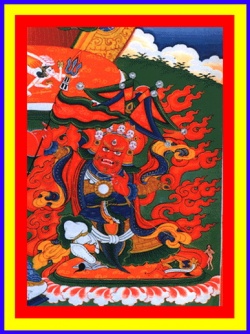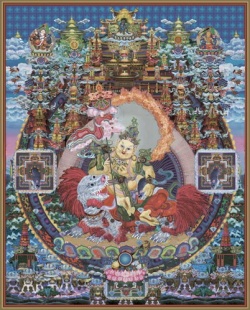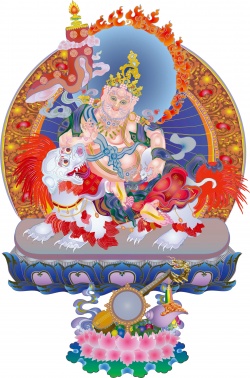Begtse
Click here to see other articles relating to word Begtse
In the Buddhism Buddhist Religion Begtse is called Beg Tse Lcam Sring in Tibetan, and Prana Atma in Sanskrit and is translated into English as "the Great Coat of Mail".
He is the main protector for the Hayagriva cycle of practice. The Dharma Protector Begtse originally was considered [[Lord of[War]] in Central Asia.
He was taken to be the son of a demon (yaksha) and a goblin (rakshasi). Begste is considered a lower protector because he did not achieve complete Liberation.
A Buddhist can not take Refuge with him but can urge him to perform the good work of protecting institutions and practitioners of the Dharma.
Prana Atma (Begtse or Cham-Sin in Tibetan) is one of the eight principal Dharmapalas (Chokyong in Tibetan), together known as the Ashta-Dharmapala or the Eight Terrible Ones.
In Tibetan Buddhism Begtse is called Beg tse chen Lcam Sring in Tibetan, meaning "the Great Coat of Mail" and Prana Atma in Sanskrit. In the Sakya and Kagyu Traditions he is considered the main protector for the Hayagriva cycle of practice.
It is a commonly held belief of some Mongolian tribal groups that Dharma Protector Begste was a Lord of War in Central Asia.
In some Tibetan texts narrating the origins of the various Protectors of Tibetan Buddhism he was taken to be the son of a demon (yaksha) and a goblin (rakshasi).
Some schools of Tibetan Buddhism believe that Begtse is a Wisdom Deity - meaning completely Enlightened. Other schools believe him to be a lower protector - Worldly Deity.
The protector was later adopted and incorporated into the Gelug School of Tsongkapa and subsequently became popular in Mongolia - predominantly following the Gelug tradition since the 17th century.
Begtse Chen is the main protector associated with the Hayagriva cycle of Tantric Deity Meditation practice.
For over one hundred years Western scholars have published the history of Begtse erroneously as beginning with the 3rd Dalai Lama and the subjugation of a Mongolian War God - referring to the protector deity Begtse.
A common source given for the Western source of the story, based on Mongolian oral history, is Albert Grunwedel (1856-1935).
In Tibetan Buddhism Begtse is believed to have originated in India. The practice entered Tibet with Nyen Lotsawa in the 11th century.
It is commonly said by some sources in Mongolia that there were three Begtse Chen coral masks made at approximately the turn of the century a little over a hundred years ago.
Currently there are at least three masks in museums in Mongolia, another mask is in the collection of the Rubin Museum of Art in New York City.
Aside from these there are numerous masks available on the Asian Art market either real or copies. It is not easy to distinguish between the original Mongolian masks and the modern copies.
One of the ten wrathful Dharmapalas, Begtse stands on a Lotus base, with his right leg bent and left leg extended, a typical posture for wrathful deities.
He has three wide-open Eyes and an angry countenance on his face, four fangs appear in his opened mouth. He steps on two corpses, a Horse and a human figure, lying on the pedestal.
Begtse wears the crown of five skulls, armor, red silk garment and garland of freshly severed heads. On his chest is the mirror with the seed syllable.
His right hand brandishes the scorpion-handled sword, his left hand holds the Heart of enemies, and in the crook of his arm are the banner, bow, and arrow.
Rikpay Lhamo, is Begtse's consort She has a red face and a naked blue Body and rides on her bear who is chewing on a corpse. She lifts up her sword and holds iron phurbu in her left hand.
On Begtse's left is the Laihansorogdog, charging on his wolf with his banner and dressed in armor. In a front row, Begtse's attendants are in various positions.
Begtse Deity is also known as Tricpa Chamsin. One is one of the main Protectors of the Sakya school, he is also a Dharma Protector of the Gelugpa school as well.
He is also known as the father of Noo-jin Tseu Marpo. Here is a history of Begtse Deity according to the Sakya Lama Tsarchen Losal Gyatso.
Many Kalpas ago two sons were born in the family of king Sergyi Shugchan and queen Upale Ke.
The older brother's name was Trakden and the younger brother's name was Trakgye. They had different religious beliefs and they could not agree with each other.
They had many Debates. In these Debates whoever lost had to follow the winner's Religion. The older brother won but the younger one refused to follow him and ran away.
The older brother caught him and tried to punish him, but the younger brother said: "Even if you will try to kill me I will not accept your Religion, please let me go and I promise in the future when you will reach Enlightenment, I will protect your teachings".
The older brother released him and gave him a set of copper armour, a coral stick, an arrow and a bow; and he gave him the name Sogtag Yamshi Marpo. Then they split.
In another lifetime when the older brother became Buddha (Shakyamuni), the younger brother was born in the North West Marutse cemetery.
His father's name was Nujin Zangkiralpachen and his mother's name was Sinmo Thrakiralbachin. The parents laid two eggs, one of them was coral, another one was "se" (name of material).
Those eggs flew in the sky, conquering many gods, then they flew into the Earth, conquering many Nagas.
They even threatened their own parents. The parents asked Akachati, Mahakala's mother, for protection and Akachati threw her katamka ( a Ritual stick) at the eggs and broke them. From the coral egg a coral man with yellow Hair bound on the top of his head came out.
He was wearing copper armor, carrying a copper sword, an arrow and a bow and a coral stick. He said:" My name is Sogdag Yamshu Marpo".
From another egg the blue female came out. She had shell teeth and turquoise eyebrows, her Hair was made out of Fire. She was wearing an agate and lapis lazuli necklace. She was carrying a copper knife and a Purba and she was riding a man-eating bear.
Akachati subdued them. Thus they became the Dharma Protectors.
The lineage of this Deity was carried by Marpa Losawa and Ne Lotsawa. Ne Lotsawa gave it to Nakaupa. Nakaupa gave it to Sachen Kunga Nyingpo. Thus Begtse Chamsin (brother and sister) became Protectors of the Sakyapa.
The protector deity Begtse Chen, (English: the Great Coat of Mail. Sanskrit name:
Prana Atma), was popularized within the Sarma (new) Schools of Tibetan Buddhism by Marpa Lotsawa (1012-1096) and Sachen Kunga Nyingpo (1092-1158), the respective founders of the Marpa Kagyu and Sakya Traditions of Tibetan Buddhism.
Colloquially Begtse is known as red Mahakala and ranks relatively high in the Sakya protector pantheon of Wisdom Deities. However, in the various Kagyu Traditions it is now rare to even find Begtse Chen.
The protector was later adopted and incorporated into the Gelug School of Tsongkapa and subsequently became popular in Mongolia - predominantly following the Gelug tradition since the 17th century.
The majority of the Art objects in the gallery below were created within a Gelug context and many of them are of Mongolian origin.
Deity Figures:
1. Begtse Chen
2. Mistress of Life (consort)
3. Lord of Life (son)
4. Eight Butchers (inner retinue)
5. Twenty-one Butchers (outer retinue)
(Twenty-nine Butchers in total)
Begtse Chen is the main protector associated with the Hayagriva cycle of Tantric Deity Meditation practice.
For over one hundred years Western scholars have published the history of Begtse erroneously as beginning with the 3rd Dalai Lama and the subjugation of a Mongolian [[War [God]] - referring to the protector deity Begtse.
A common source given for the Western account of the story, based on Mongolian oral history, is Albert Grunwedel (1856-1935).
In Tibetan Buddhism Begtse is believed to have originated in India.
The practice entered Tibet with Nyen Lotsawa in the 11th century.
Begtse is a War God who emerged in the 16th century, making him the most recent Dharmapala. His legend is woven together with Tibetan history:
Sonam Gyatso, the Third Dalai Lama, was called from Tibet to Mongolia to convert the warlord Altan Khan to Buddhism. Begtse confronted the Dalai Lama to stop him.
But the Dalai Lama transformed himself into the Bodhisattva Avalokiteshvara. Witnessing this miracle, Begtse became a Buddhist and a protector of the Dharma.
In Tibetan Art, Begtse wears armor and Mongolian boots.
Often he has a sword in one hand and an enemy's Heart in the other. A God of War in Tibetan Bon-Religion.
He is covered in chain-mail from head to toe and carries a sword. In Lamaism he is one of the divine keepers of the Buddhistic teachings (Dharmapalas).
He often appears as lCam-srin.
Lineage from India: Vajradhara, Mahadeva, Nyi Od Dragpa, Dawa Nagpo, Shridhara Krashu, Nyen Lotsawa Dharma Drag, Khau Chokyi Gyaltsen, Sachen Kunga Nyingpo (1092-1158), etc.


